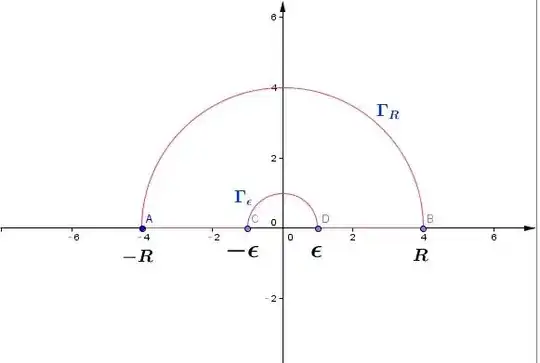this integral:
$$\int_0^{+\infty}\frac{\sin x}{x}\text{d}x=\frac{\pi}{2}$$
is very famous and had been discussed in the past days in this forum. and I have learned some elegant way to computer it. for example: using the identity: $\int_0^{+\infty}e^{-xy}\sin x\text{d}x=\frac{1}{1+y^2}$ and $\int_0^{\infty}\int_0^{\infty}e^{-xy}\sin x\text{d}y\text{d}x$ and Fubini theorem. the link is here:Post concern with sine integral
In this post, I want to discuss another way to computer it. since$$\int_0^{+\infty}\frac{\sin x}{x}\text{d}x=\frac{1}{2i}\int_{-\infty}^{+\infty}\frac{e^{ix}-1}{x}\text{d}x$$
this fact inspire me to consider the complex integral:$$\int_{\Gamma}\frac{e^{iz}-1}{z}\text{d}z$$

and $\Gamma$ is the red path in the above figure, with counter-clockwise orientation, by Cauchy's theorem, we have
$$\int_{\Gamma}\frac{e^{iz}-1}{z}\text{d}z=0$$ the above integral can be written as:$$\int_{-R}^{-\epsilon}\frac{e^{ix}-1}{x}\text{d}x+\int_{\Gamma_{\epsilon}}\frac{e^{iz}-1}{z}\text{d}z+\int_{\epsilon}^{R}\frac{e^{ix}-1}{x}\text{d}x+\int_{\Gamma_{R}}\frac{e^{iz}-1}{z}\text{d}z$$
Let $R\rightarrow +\infty$ and $\epsilon \rightarrow 0$, we have:
$$\int_{-R}^{-\epsilon}\frac{e^{ix}-1}{x}\text{d}x+\int_{\epsilon}^{R}\frac{e^{ix}-1}{x}\text{d}x \rightarrow \int_{-\infty}^{+\infty}\frac{e^{ix}-1}{x}\text{d}x=2i\int_0^{+\infty}\frac{\sin x}{x}\text{d}x$$
and $$\int_{\Gamma_{\epsilon}}\frac{e^{iz}-1}{z}\text{d}z=\int_\pi^0\frac{e^{i\epsilon e^{i\theta}}-1}{\epsilon e^{i\theta}}i\epsilon e^{i\theta}\text{d}\theta=i\int_\pi^0(\cos(\epsilon e^{i\theta})+i\sin(\epsilon e^{i\theta})-1)\text{d}\theta \rightarrow 0$$ as $\epsilon \rightarrow 0$
so I am expecting that:$$\int_{\Gamma_{R}}\frac{e^{iz}-1}{z}\text{d}z=-i\pi$$ when $$R \rightarrow +\infty$$
but I can't find it. Could you help me? Thanks very much.